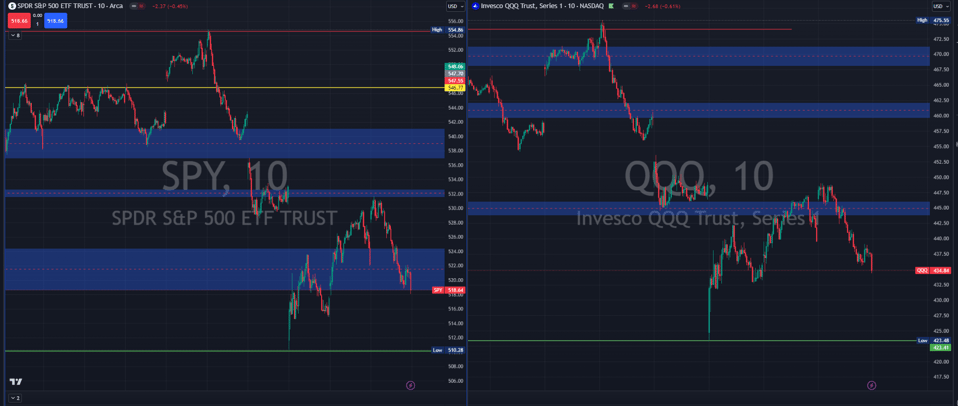Market Review 7th August 2024
Simplify the craziness
DAILY REVIEW
N
3 min read
Wednesday Market Activity
On Wednesday, August 7, 2024, U.S. and Canadian markets attempted to build on a recovery but ultimately reversed course, closing lower. The Nasdaq, with its heavy concentration of technology stocks, lagged behind both the S&P 500 and the Canadian TSX. This decline occurred despite a tepid demand for the U.S. 10-year Treasury bond auction. In contrast, global markets experienced a rebound, with the Eurozone's Euro Stoxx index and Japan's Nikkei both rising by over 1.0%.
The Bank of Japan’s commitment to maintaining low-interest rates amidst financial market volatility bolstered market sentiment in the region. Meanwhile, U.S. Treasury bond yields rose, with the 10-year yield climbing back to around 3.95%, a significant increase from its intraday low of 3.66% on Monday. The VIX volatility index, commonly referred to as Wall Street's "fear gauge," modestly increased to around 28, following a peak of over 65 earlier in the week—the highest level since 2020. In our assessment, markets may remain volatile through the typically weaker months of September and October and leading up to U.S. Election Day. Nevertheless, we believe the fundamentals of this bull market remain strong, underpinned by an anticipated Fed rate cut and sustained corporate earnings growth.
Strong Corporate Earnings
Despite last week’s market volatility, driven by disappointing earnings reports from major technology companies like Intel and Amazon, corporate earnings growth remains robust. Intel missed earnings expectations and announced a suspension of its dividend, while Amazon exceeded expectations but issued cautious forward guidance. However, at an index level, S&P 500 earnings are on track to grow by over 11% in the second quarter, exceeding the initial 7.8% expectation at the beginning of July and surpassing the 5.8% growth rate of the first quarter. For the full year, S&P 500 earnings are expected to increase by over 10%, which, if achieved, will provide solid support for equity markets.
As we approach the fourth quarter of 2024, the contribution to earnings growth is expected to broaden beyond the technology sector. This diversification in earnings growth supports the case for expanding market leadership across both growth and value/cyclical segments of the market.
Economic Growth: Cooling but Not Collapsing
Recent economic data suggests that while growth is slowing, it is not collapsing. Last week's U.S. jobs report showed nonfarm payrolls increased by 114,000 in July, significantly below the 175,000 expectation. Additionally, the unemployment rate rose to 4.3%, the highest since 2021. Although the gain in nonfarm payrolls represents a slowdown from recent months, the three-month average gain of approximately 170,000 remains consistent with the average monthly gain in the decade leading up to the pandemic.
The rise in unemployment was primarily driven by an increase in labor supply, with more people joining the workforce, rather than a contraction in employment. On the growth front, U.S. real GDP grew by 2.8% in the second quarter, and the Atlanta Fed’s GDPNow tracker estimates third-quarter growth at 2.5%. These indicators suggest a labor market and economy that are cooling but not collapsing.
Next week, the release of the latest Consumer Price Index (CPI) inflation readings is anticipated, with headline CPI inflation expected to fall to 2.9% year-over-year in July, down from 3.0% in June. This combination of slowing but positive economic growth, moderating inflation, and an anticipated Fed rate cut remains supportive of financial markets broadly.
Market Outlook
Despite recent fluctuations and uncertainties, the underlying factors driving the market remain positive. The anticipation of easing monetary policy, robust corporate earnings, and a cooling but stable economic environment provide a solid foundation for continued market growth.
Investors should remain focused on their long-term goals, avoiding decisions driven by short-term market movements. Market volatility, while uncomfortable, is a normal part of the investment landscape. Historical data shows that missing just a few of the best days in the market can significantly impact long-term performance. From 1994 to 2023, the S&P 500 returned just over 10% per year on an annualized basis. However, missing just 10 of the best days during this period reduced the annualized return to 7.3%.
Conclusion
The markets’ midweek reversal amidst ongoing volatility highlights the importance of maintaining a disciplined investment strategy. While the near-term outlook may be characterized by choppy market conditions, the broader macroeconomic and fundamental backdrop remains supportive of growth. Easing monetary policy, strong corporate earnings, and a cooling but stable economy provide a resilient foundation for the markets.
As we navigate through the typically weaker months of September and October and approach U.S. Election Day, it is crucial for investors to stay focused on their long-term objectives and avoid making decisions based on short-term market fluctuations. The resilience of global markets amidst recent volatility underscores the importance of a balanced, disciplined approach to investing.
In summary, while the markets may face short-term challenges, the long-term outlook remains positive. Investors should remain vigilant but focused on their long-term goals, recognizing that market volatility is a normal part of the investment journey. The fundamentals driving the current bull market, including anticipated Fed rate cuts and strong corporate earnings, remain intact, providing a solid foundation for continued growth.
$NVDA $TSLA $AAPL $META $SMCI $MSFT $AMZN $AMD $AVGO $LLY $V $ABNB $SHOP $GOOG $DIS $MU $UNH $CRWD $UBER $PLTR $NFLX $DELL $INTC $JPM $LUMN $BAC $FTNT $XOM $UPST $COIN $QCOM $AMGN $PG $BKNG $COST $MSTR $CVX $WMT $GS $ABBV $AXON $AMAT $HD $CEG $MRK $MELI $ORCL $PANW $C


